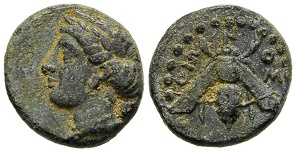Fine Coins Showcase
Antiquities Showcase
Show Empty Categories
Shop Search
Shopping Cart
My FORVM
Contact Us
About Forum
Shopping at Forum
Our Guarantee
Payment Options
Shipping Options & Fees
Privacy & Security
Forum Staff
Selling Your Coins
Identifying Your Coin
FAQs
zoom.asp
Home ▸ Catalog ▸ |Themes & Provenance| ▸ |Types| ▸ |Insects||View Options:   | | | | | | |


On the significance of this unusual issue, Dr. Philip Kinns, one of the authors of "The Pixodarus Hoard (CH 9. 421)" in Coin Hoards IX (2002), had this to say in the paper: "A small bronze series that must be contemporary with the class C tetradrachms can be identified. The types are head of city goddess or Cybele left, with astragal behind, and on the reverse a bee with magistrate's name above and surrounded by a border of dots. This is the only Ephesian bronze series without the ethnic, and the earliest to have magistrates' names, those recorded being EΠIΓONOΣ, HΓEΛOXOΣ and OIΩNOΣ. The same three men share obverses 19 and 21 in the tetradrachms, with Epigonos and Oionos also linked by obverses 22 and 23. This bronze series was dated c. 280 - 258 by Head, but we can now affirm c. 375 as the likely time of issue, given that the Yaka hoard, buried c. 365, also included tetradrachms from the following class D."GB114694. Bronze AE 12, Head Ephesus p. 131, Period VIII, Group β, 13 (pl. III, 15); otherwise likely unpublished, VF, attractive dark green patina, highlighting reddish earthen deposits, magistrate's name bold and complete, rev. die crack, weight 1.616 g, maximum diameter 12.2 mm, die axis 0o, Ephesos (near Selcuk, Turkey) mint, c. 375 B.C., magistrate Oionos; obverse laureate laureate and turreted head of city goddess or Cybele left, wearing necklace, astragalos behind neck; reverse OIΩ-N-OΣ, bee seen from above, straight wings; very rare;
Egyptian, Late Period - Ptolemaic Period, Faience Scarab, 664 - 30 B.C.


AS96367. Egyptian scarab, 8.1mm long; bright light green faience, flail on base, pierced for suspension, near Choice, 664 - 30 B.C.; from Alex G. Malloy with his certificate of authenticity;
Ioulis, Keos Island, Cyclades, Greece, 3rd - 2nd Century B.C.


Ktesylla was a girl born at Ioulis, Keos who eloped with her lover and died in childbirth. After her body disappeared an oracle instructed the people to found a sanctuary called Ktesylla. An annual sacrifice was made to her at Ioulis.
The bee on the reverse is an allusion to Aristaeos. At a time when Keos was suffering from drought and pestilence Aristaeos appeared on Keos and sacrificed to Zeus Ikmaios, who caused refreshing breezes to blow for forty days. Aristaeos also instituted propitiatory sacrifices to the dog-star Seirios, and instructed the Kean Nymphs in bee-keeping and other arts. GB29362. Bronze AE 11, Papageorgiadou-Banis Series XII; cf. BMC Crete p. 96, 71 (includes ethnic); SNG Cop -, aVF, weight 1.818 g, maximum diameter 11.4 mm, die axis 0o, Iulis mint, obverse diademed head of Ktesylla right; reverse bee within laurel wreath; rare; SOLD
Ioulis, Keos Island, Cyclades, Greece, 3rd - 2nd Century B.C.


Ktesylla was a girl born at Ioulis, Keos who eloped with her lover and died in childbirth. After her body disappeared an oracle instructed the people to found a sanctuary called Ktesylla. An annual sacrifice was made to her at Ioulis.
The bee on the reverse is an allusion to Aristaeos. At a time when Keos was suffering from drought and pestilence Aristaeos appeared on Keos and sacrificed to Zeus Ikmaios, who caused refreshing breezes to blow for forty days. Aristaeos also instituted propitiatory sacrifices to the dog-star Seirios, and instructed the Kean Nymphs in bee-keeping and other arts. GB29815. Bronze AE 10, BMC Crete p. 96, 71; Papageorgiadou-Banis Series XII, SNG Cop -, F, weight 1.109 g, maximum diameter 10.1 mm, die axis 0o, Iulis mint, obverse diademed head of Ktesylla right; reverse IO-Y, bee within laurel wreath; rare; SOLD
CLICK HERE TO SEE MORE FROM THIS CATEGORY - FORVM's PRIOR SALES



Page created in 1.14 seconds.








